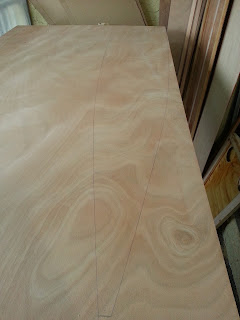I decided to leave the hulls alone for a minute and work on the iako (cross beams). I am building them hollow like Gary Dierking wrote about
here.
I decided to just use some cheap and readily available radiata pine boards for the iako, and grabbed them from the local big box store. I also dug an almost clear (one knot towards one end) 2x4 with good grain out of the $3 pile. I'll be able to rip some good lengths out of that for things like the rudder mounts and some other stuff later.
The radiata boards are 8' x 3.5'' x 3/4'' (2438 x 89 x 19 mm). In Gary's
article, he commented that as a rule he makes the hollow beams 10% larger than their solid counterparts. For me that will equate to beams of 77 x 62 mm. Since I'm using 4mm ply for the beam sides, I need to reduce the board width by 20mm, down to 69mm.
So I set up my ripping sled for 20mm cut and ripped a length off one of the boards; then promptly realized I forgot to take into account the size of kerf...so I ended up with 67mm instead. Oops, so my beams will be 75 x 62 mm then, no big deal I think.
The article used 5/8'' / 16mm boards, mine are currently 19mm. My beams will just be straight boxes, no bending or anything, so I could just leave them at 19mm I guess. However, I'm trying to keep things as light as possible; for one because I'm adding extra weight elsewhere with the self bailing cockpit, rudder stuff, etc; and secondly because the lighter it is, the easier it will be to move around, lift on a car, etc...and be all around more enjoyable to deal with I think.
So anyway I weighed the boards, did some calculations, and came to the conclusion that reducing the boards to 15mm will shave off just over 3 pounds. Doesn't sound like much, especially when I think about the work I'm in for using a hand plane to do it...but every little bit helps. Save me a trip to the gym anyway... ;)
I work the plane down the board at an angle, across the grain. When I reach the end, I work my way back with opposite angle, making an X like pattern. Going straight across grain results in tear out; a scrub plane or at least a cambered blade would probably do a cleaner, quicker job. Starting with largest cuts I can get away with without knocking my makeshift work bench around to much, and getting lighter as I get closer to the line. Then I switch to long strokes with the grain to smooth and flatten it out, and finish with a sanding block.
 |
| Marking gauge set for 15mm. |
 |
| Board marked on both sides. |
 |
| Trusty jack plane put to work. |
 |
| Done yet? |
 |
| Looks good! |
And only three more to do! A lot of work, and a bit time consuming, but enjoyable and rewarding in its own way...

















































